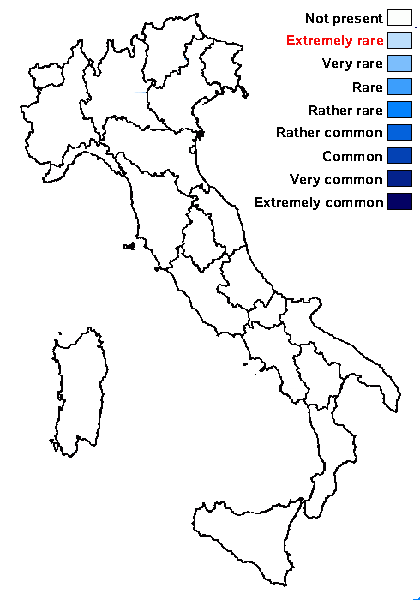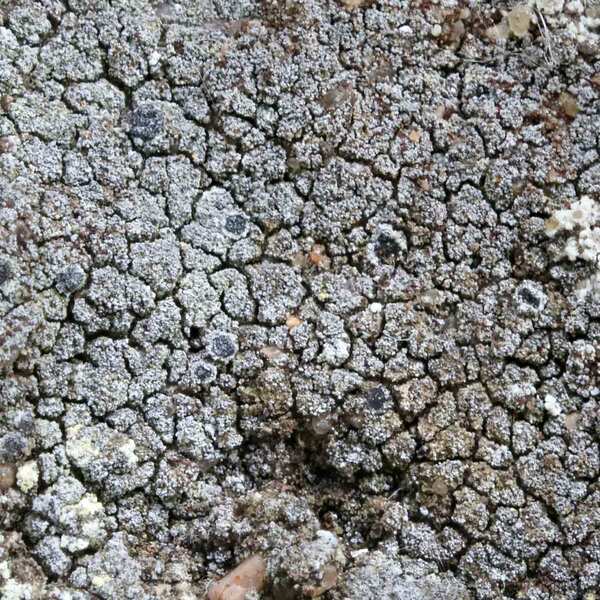Lecania coeruleorubella (Mudd) M. Mayrhofer
Bibl. Lichenol., 28: 47, 1988,. Basionym: Lecania coerulescens var. coeruleorubella Mudd - Man. Brit. Lich.: 141, 1861.
Synonyms: Lecania nylanderiana A. Massal. var. coeruleorubella (Mudd) Zahlbr.
Distribution:
Description: Thallus crustose, rimose or areolate, thick, yellow-brown to brown-grey, densely covered in flattened to globose 45-65 μm wide, glossy blastidia which are often arranged in chains. Cortex c. 40 µm thick; medulla white, I-. Apothecia lecanorine, round or irregular in outline, 0.5-1.2 µm across, sessile or adnate, sometimes constricted at base, with a red-brown to black, but often grey-pruinose, flat to slightly convex disc, and a brown-grey, swollen, irregularly cracked to incomplete, blastidiate thalline margin. Thalline exciple thick, rich in algal cells; epithecium reddish-brown, with a granular epipsamma; hymenium colourless, 50-70 µm high, paraphyses simple or shortly branched and submoniliform in upper part, c. 2.5 µm thick at mid-level, the apical cells swollen, 3-5(-7) µm wide; hypothecium colourless or pale brown, 25-40 µm high. Asci 8-spored, bitunicate, with a K/I+ blue tholus and a central non-amyloid area, Biatora-type. Ascospores (1-)3-septate, hyaline, narrowly ellipsoid, straight or curved, (12-)17-22(-25) x 4-5 μm, thin-walled, without a gelatinous perispore. Pycnidia very rare, reddish brown around the ostiole. Conidia thread-like, straight to slightly curved, 10-14 x c. 0.8 µm. Photobiont chlorococcoid. Spot tests: K-, C-, KC-, P-, UV-. Chemistry: without lichen substances. Note: on mortar and limestone on shaded walls; widespread in Europe, with a few, mostly historical records from the Eastern Alps (Austria); to be looked for in Italy.
Growth form: Crustose
Substrata: rocks
Photobiont: green algae other than Trentepohlia
Reproductive strategy: mainly asexual, by soredia, or soredia-like structures (e.g. blastidia)
Commonnes-rarity: (info)
Alpine belt: absent
Subalpine belt: absent
Oromediterranean belt: absent
Montane belt: absent
Submediterranean belt: extremely rare
Padanian area: absent
Humid submediterranean belt: absent
Humid mediterranean belt: absent
Dry mediterranean belt: absent

Predictive model
Growth form: Crustose
Substrata: rocks
Photobiont: green algae other than Trentepohlia
Reproductive strategy: mainly asexual, by soredia, or soredia-like structures (e.g. blastidia)
Commonnes-rarity: (info)
Alpine belt: absent
Subalpine belt: absent
Oromediterranean belt: absent
Montane belt: absent
Submediterranean belt: extremely rare
Padanian area: absent
Humid submediterranean belt: absent
Humid mediterranean belt: absent
Dry mediterranean belt: absent

Predictive model
 INDEX FUNGORUM
INDEX FUNGORUM
 GBIF
GBIF


